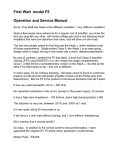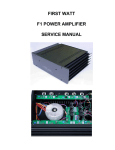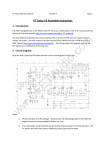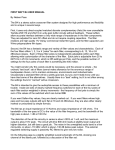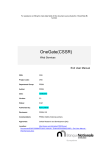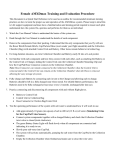Download M2 Manual - First Watt
Transcript
First Watt model M2 Power Amplifier Dear Customer, Thank you for your interest in this product. The First Watt M2 is a two channel audio power amplifier delivering 25 watts per channel. It uses JFET and MOSFET transistors operating in Class A mode without negative feedback so as to produce a more musically life-like sound. Negative feedback is a technique in which the input gain stage of an amplifier compares the input musical signal with the output of the amplifier and outputs a signal to the remainder of the amplifier which incorporates the original music mixed with corrections to reduce the errors made by the rest of the amplifier. If an amplifier has fairly high distortion, then negative feedback is very helpful in cleaning up the output going to the loudspeaker. Nevertheless many audiophiles view it as a necessary evil, affecting the musical quality of the sound. If we had a more perfect amplifier, one with intrinsically low distortion, we could consider removing negative feedback and its undesired artifacts altogether. This is what the M2 does. Making a good amplifier without feedback is not an easy trick. It has been done before by several means. While most tube amplifiers use negative feedback to get distortion down to acceptable levels, there are a few examples that don't, often SET amplifiers, which are single-ended Class A tube circuits. SETs generally rely on the “load-line” character of power triodes such as 300B's to self-cancel undesired distortion and provide a reasonably low output impedance, and they have garnered a following among audiophiles with high efficiency loudspeakers. There are some serious limitations to this approach – low power and relatively high (~1%) harmonic distortion. This results in a pleasant and very musical character at low levels and with simple material which tends to fall apart and become mushy when asked to recreate complex dynamics. Some advocates of “low distortion” transistor amplifiers have commented that SET enthusiasts like that distortion, and that is why they prefer these designs. I don't accept this argument. Having owned a few, I think that these tube circuits are enjoyed in spite of their flaws. It is my experience that as these designs are improved for greater linearity, they sound better. It is my belief that the virtues of these amplifiers are in the smoothness of their transfer curve, the simplicity of their design, and no feedback. There have also been transistorized efforts at no-feedback, with varying degrees of success. The ones that have sounded the best tend to be a bit like their tube counterparts – simple and smooth. There have been more powerful and complex amplifiers made, and I consider them worthy achievements, but somehow they miss the slightly romantic touch of their small Class A counterparts. Ah well, this is the entertainment industry after all, and the key thing is to find the amplifier that makes you happy. This means that a variety of amplifiers are needed, and there is no reason to claim the general superiority of one design over another, in the same way that there is no perfect automobile or bottle of wine. In an effort to please audiophiles who like no-feedback tubes but are a little tired of their limitations, I have developed the M2. The M2 is a simple circuit whose output stage consists of a pair of complementary power Mosfet followers biased into pure Class A mode. These devices are the current gain stage of the amplifier, very linearly following the musical signal produced by the voltage gain stage. Actually, this is the easy part, and I've done it many times before. The voltage gain stage which precedes the output followers is where you usually have the most problems with distortions of various sorts. This is because the mode of operation required (common-cathode, common-source, or common emitter) is the least linear, requiring both voltage and current gain. There are numerous approaches, but it usually boils down to either accepting higher distortion or more complexity. The M2 is different. It uses a passive voltage gain device, an auto-former. Like a transformer, an auto-former is a magnetically coupled circuit which changes the ratio of voltage and current while keeping the same amount of energy. In this case, it steps up the voltage by a factor of 5 in exchange for delivering 1/5 the current at the output. Since the input impedance of the output stage devices is very high, this is an equitable exchange. Not that the auto-former is without faults – it too has distortion and bandwidth limitations, but they are pretty reasonable and musical, especially keeping in mind that they outperform the big power transformers required on the outputs of the SET and other tube amplifiers. The input impedance of this system is about 6 Kohms, which is easily driven by most equipment, but since we are trying to please the tube crowd here, the M2 also uses a complementary pair of JFETs as a very low distortion input buffer, so that the input impedance can be set at 100 Kohms. So here we have a no-feedback Class A FET power amplifier with transformer voltage gain. Does it have any similarities to no-feedback Class A tube amplifiers with an output transformer? Yes and no. It does have some of the qualities that SET aficionados look for. The auto-former does bring its own signature to the sound, although in smaller doses than we usually experience. The midrange has a lush, warm character that I associate with tubes and transformers, but subtly so. Part of this is due to the limited bandwidth of transformers, and part of it is the lack of feedback artifacts. On the other hand, there is considerably less harmonic distortion than with nofeedback SETs, and if you really do like that distortion then the M2 might not be what you want. Also, there is more power than usual and a relatively high damping factor, so the M2 is different in that regard. The M2 strikes a balance in the performance space between the extremes of big behemoth solid state power amplifiers and little tiny single-ended triodes. I think you will find the M2 a very pleasant amplifier to listen to. It is relaxed and lively with a slight softness to both the bottom and top frequencies. I hope that you will find as I do that it disappears and leaves the music for you to enjoy. I also hope that it will make you go back through your entire record collection and make you listen to it all over again. Since that might take years, please enjoy. Best regards, Nelson Pass First Watt amplifiers are hand built by myself and my son and my nephew. Since they are still learning the craft, I supervise and perform the last assembly steps and testing myself. I don't mind doing this – it keeps me connected to my designs and assures me that our customers receive our best effort Distortion Measurements The distortion characteristic of the M2 reflects the symmetry of the complementary gain stages and also the symmetry of the magnetic characteristic of the voltage gain auto-former. With Class A operation, this results in a fairly pure third harmonic signature, as seen in the graphic below, where an amplified 1 Khz tone produces as small amount of 3 Khz harmonic: In the graph below, you can see the distortion into 8 ohms at 1 Khz from 0.1 watt to above 25 watts: Here is that distortion curve into 4 ohms: Lastly, here's the distortion vs frequency at 1 watt: Most of the distortion in the M2 represents the performance of the auto-former which performs the voltage amplification. Many magnetic circuit products were evaluated in the development of this amplifier – some measured better, some measured worse. The final choice went to the part that actually sounded the best in blind listening sessions. Setup The initial setup of the amplifier is very straight-forward. Place the amplifier in a well-ventilated location, as it draws about 160 watts during operation and requires as much opportunity to cool itself as possible. You should be able to put your hands on the heat sink during operation. If you can't do this for 5 seconds or so, they need more ventilation. On the front panel there are two blue LED lights, one for each channel, indicating regulated power to the channel. If the light is on, the power supply for that channel is delivering voltage. On the rear panel you will find pairs of RCA inputs, speaker outputs, a fuse holder, an AC power receptacle, and on/off switch and a label. The label will indicate a serial number and also what AC line voltage the amplifier is set for. If the voltage is 120V or 100 V, then the fuse value will be a 3AG slow blow fuse rated at 2.5 amps. If the voltage is 220-240 V, then the fuse will be rated at 1.25 amps. Do not substitute a larger value fuse. Contact First Watt if you have any questions. I'm assuming that you know how to attach the speaker cables to the 5 way output connectors provided. I recommend that you make all the connections with the amplifier power switch in the OFF position, but you will not damage the amplifier circuit by accidentally shorting the output or overdriving the input - my concern is more for the safety of any fragile loudspeaker driver you might be using. With everything connected up and the source equipment powered up first, you can proceed to turn on the power switch to the amplifier. Turn-on and turn-off thumps and noise are small in this amplifier, and should not present any hazard to delicate drivers. It takes about 1 minute for the regulators to come up to full voltage, so don’t expect full output power for that time. At this point you should be able to listen to music. The power supply of the amplifier is isolated from the chassis and AC earth ground by a thermistor which connects the circuit ground to the chassis and earth ground. This helps to prevent ground loops, but the thermistor stands by to conduct AC line voltage to ground until the fuse blows in case of transformer or other such failure. The input impedance is 100 Kohms, and the input capacitance is very low - only a few picofarads, so you will find it easy to drive it with single-ended tube equipment if you like. The M2 has enough damping factor at 20 to work well with loudspeakers that mate well with tube amplifiers in general, and it delivers good performance into 4 ohms also – see the distortion curves. It is designed around relatively high efficiency speakers and it particularly shines with those that have 90 dB/watt sensitivity or greater, but you can hook it up to anything you like, as long as you adjust your expectations as to how loud it will play. The amplifier requires about 1 hour of operation to reach normal operating temperature, and this warm-up time is appropriate for the most critical listening, but is not otherwise an issue. The amplifier’s final adjustments were been made after an hour, but the performance difference between 1 minute and 60 minutes is not very great. I do not personally see a reason to run the amplifier all the time, but you can do that if you want to. The power supply capacitors are likely to last about 15 years or so, and while they will slowly dry out just sitting there, they will have a shorter life span with the amplifier running constantly. Also, at 200 watts it makes economic sense to shut the amplifier off if you aren’t planning on using it for the rest of the day. Again, the heat sinks on this amplifier run fairly hot, and you want to make sure that they get adequate ventilation. They will run at around 25 degrees C. above the ambient temperature, which puts them around 50 degrees in the average listening room. At this temperature you should be able to put your hand on them for about 5 to 10 seconds or so. The amplifier is capable of driving speakers which dip below 4 ohms as there are no limiters in the circuit. When the choice had to be made between sound and reliability into low impedance loads, I chose sound. For this reason please take care not to operate the amplifier into a short circuit or loads generally rated below 4 ohms. If you have any questions, contact First Watt. I answer all questions, even if the answer is no. www.Firstwatt.com [email protected] Now the following is for your protection – Do not defeat the AC line Earth ground connection on the amplifier power cord. It provides an extra barrier to prevent potential shock hazard. Do not replace the fuse with a type other than specified. Do not operate the amplifier outside in the weather, or in and around water or anything resembling water. If you spill a drink in the amplifier or if your dog/cat/child urinates on it, turn it off immediately, unplug it, and do not operate it until cleaned by a qualified technician. If something gets loose or rattles around inside or smells funny, or if you can’t touch the heat sinks for 5 seconds or so, then turn it off, unplug it from the wall, and contact First Watt. There are no user serviceable parts inside. Do not open the amplifier, and if you do anyway, don’t operate it with the cover off. There are hazardous voltages inside. If you need to change the operating AC voltage, contact First Watt. If you have a problem, contact your dealer, distributor or First Watt directly. We are much happier helping you solve problems so that we can be certain that it’s done properly. If you are far away and don’t want to ship the product for repair, we will assist your technician with information and parts. Contact: www.Firstwatt.com [email protected] Summary of the nominal specifications: Measured at 120 V AC and an 8 ohm load: Distortion @ 1 watt .025% @ 1 KHz, Input Impedance 100 Kohm Gain 14 dB Input Sensitivity 500 mV = 1 watt, 3 V = rated power Damping Factor 20 Output power 8 ohms 25 watts @ 1% THD, 1KHz Output Power 4 ohms 40 watts @ 1% THD, 1 KHz Frequency response +0, - .5 dB @ 20 Hz, 25 KHz Noise 500 uV unweighted, 20-20 KHz Power consumption 160 watts Fuse 3AG slow blow type, 2.5 Amp for 100-120V 1.25 Amp for 220-240 V Warranty: Parts and labor for 3 years, not covering shipping costs or consequential damages. Copyright 2010 General Amplifier General Amplifier Inc. 112 North Curry Street Carson City, Nevada 89703-4934










